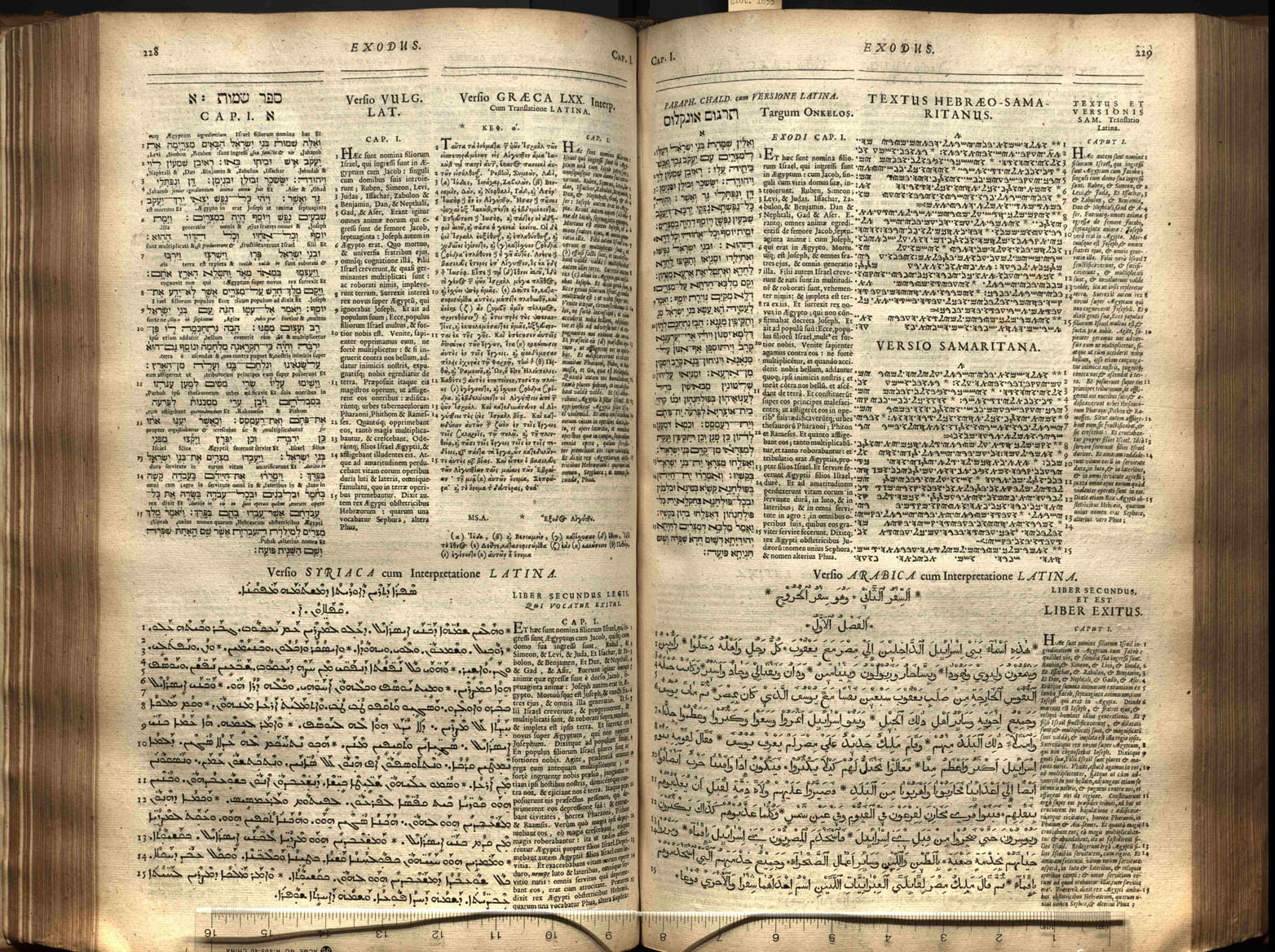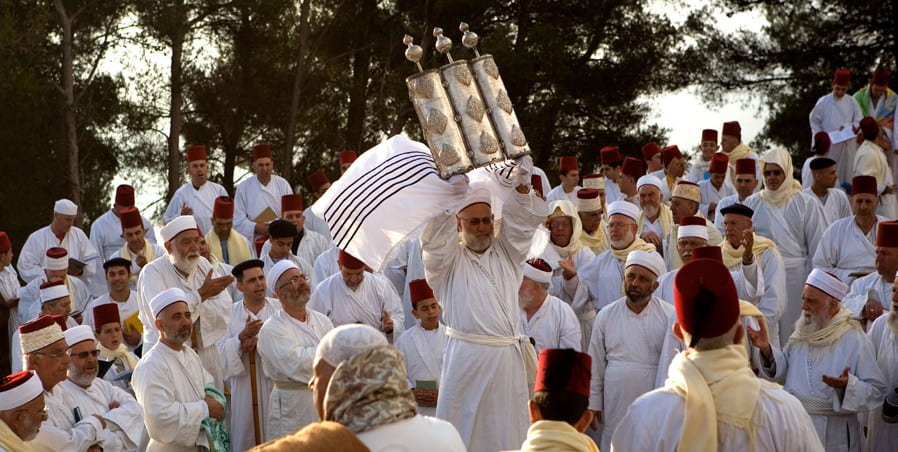by guest contributor Matthew Chalmers
“Are the Samaritans worth a volume of 360 pages?” Thus pondered an anonymous reviewer of James A. Montgomery’s The Samaritans: The Earliest Jewish Sect (1907). Today, specialists in Samaritan Studies are still arguing that they deserve broader attention—most recently in Reinhard Pummer’s 2016 survey of Samaritan history. Despite the low profile of Samaritans when compared to “world religions” like Judaism, Christianity, Islam, and Buddhism, they are an intriguing case: a Torah-observant group tracing their origins, like Jews and Christians, to ancient Israel, but worshiping God on Mount Gerizim near Biblical Shechem rather than in Jerusalem. Travelling back in time we see that our gloomy anonymous reviewer stood at the end of another arc in European scholarship, at the beginning of which Samaritans had provoked curiosity from an antiquarian as prestigious as Joseph Scaliger (1540-1609).

How did Samaritans go from being sought after by some of the most influential early modern intellectuals to being the afterthought of an early twentieth-century scholar? The answer tells us something about how ideas gain and lose academic worth. What does it mean for a scholarly project to be valued—and how can change in that valuation reveal or occlude possibilities for writing history with our archives? To answer that question it is instructive to begin by looking to what intrigued scholars about Samaritans in the early modern period.

In 1581, the famous Dutch antiquarian Joseph Scaliger confronted a problem of chronology. He knew, like the medieval and late antique chronographers before him, that the genealogies in the Samaritan Pentateuch’s version of Genesis reported the chronology of the biblical patriarchs differently from the Masoretic text used by Jews. He also grew intrigued by Samaritan Hebrew’s preservation of characters more similar to the ancient Hebrew alphabet—the alphabet he thought they shared with the Phoenicians—rather than the square script of contemporary Jews. What if the remaining Samaritan communities preserved undiscovered manuscripts capable of upending the standard view of ancient Israel, just as their chronology sometimes contradicted that of ancient Jews?
Scaliger asked his contact Claude Dupuy to write to their friend Gian Vincenzo Pinelli to ask his Jewish contact in Constantinople to acquire a Samaritan calendar. When the Samaritans responded, sending him a calendar, he reached out directly to their communities in Cairo and Shechem. Unfortunately for Scaliger, the answers were lost in the wreck of the ship carrying them back to France, the St. Victor, and he died before their recovery. Fortunately for posterity, Nicolas-Claude Fabri de Peiresc (1580-1637), an antiquarian based near Marseilles, the home port of the St. Victor, managed to recover the responses. They contained—to Peiresc at least—a treasure-trove of information and curiosities. He then spent substantial time and attention trying to obtain Samaritan manuscripts. Subsequent generations of scholars shared his interest (as Peter Miller has explored).
Peiresc and Scaliger’s search for Samaritan secrets is partly explained by how post-Reformation battles between Christian scholars incentivised control over the biblical past and spurred debate about its variant versions. Mastery of Bible manuscripts served as a primary qualification of expertise within these scholarly contests. The Samaritan Pentateuch, as Scaliger had noticed, sometimes agreed with the Greek version of those five books over against the Masoretic text, and sometimes contradicted both. A Catholic scholar such as Jean Morin (1591-1659) could thus argue that the Samaritan Pentateuch proved Protestant appeals to a pure Hebrew original were a basic mistake. Moreover, emphasizing the skills of manuscript study permitted well-connected scholars to emphasize mastery over the Bible with their superior access to the manuscripts perceived to embody the history of a text. The Samaritan Pentateuch, for this reason, found itself incorporated into two Polyglots (Paris 1628-45; London 1657). These prestigious and expensive collaborative projects printed multiple versions of the biblical text side-by-side, thus displaying the expertise of the editors while also undermining the appeal to any one ancient version (tacit: the Hebrew). For more than a century, then, the Samaritans—whilst never gaining the degree of attention granted to the great ancient civilizations of Greece, Rome, Egypt, and Israel—mattered.
How, then, did Samaritans go from this relative prominence to almost total neglect at the turn of the twentieth century? As Arnaldo Momigliano has demonstrated, antiquarianism, and its fractal approach to the historical past, never really went away. Nor did the attachment of scholarship to Christian goals. But the world of learning had been reconfigured. Research into Samaritans, for instance, calls for some expertise in Hebrew and Arabic as well as the languages of Mediterranean antiquity. This antiquarian combination jarred with the philological segmenting of the nineteenth-century university (except for German Jewish scholars who, as Susannah Heschel has tracked in her research on Abraham Geiger, were increasingly excluded by anti-Judaism).
In the nineteenth and twentieth century, moreover, antiquarianism proved no match for political, national, and racial logic in incentivizing the selection of material for study. During the global expansion of European power, “religion” came to function in what David Chidester has called an “empire of religions.” Scholarly approaches framed religious history vis-à-vis tension between universal “civilization” and “the primitive” as a means to formulate universally applicable difference between European Christians and non-Europeans, between proper Christians and deviant Christians, or between European Christians, Jews, and Arabs. In turn, such intellectual practices encouraged methods best able to order taxonomies of knowledge according to progress towards a universal prototype embodied in an imagined “modern” or “Christian” Europe. The Samaritans, a small group which most commentators expected to disappear, whose historical appearances are intermittent enough to resist smooth narrativization, made too small a splash in a research space dominated by universals with all-encompassing scope.
Even the biblical basis for Samaritan prominence that drove the interest of scholars like Morin fell on hard times. Wilhelm Gesenius, one of the primary contributors to Semitic language pedagogy, had little patience for the potential priority of the Samaritan Pentateuch. His 1815 De Pentateuchi Samaritani origine, indole et auctoritate commentatio philologico-critica demonstrated to the satisfaction of most Bible scholars that the potential of the Samaritan text to witness an earlier version of the Hebrew Bible was a pipe dream. Similarly, his grammar—first published in 1813 but used even today as a pedagogical touchstone—dismisses Samaritans as a minor subset of north-west Semites, characterized by ethnic and linguistic mixture. In the first decades of the twentieth century scholars like Paul Kahle and Moses Gaster attempted to rehabilitate the Samaritan Pentateuch as worthy of scholars’ time. But it was too little to retain Samaritans within the Biblical Studies mainstream.
The publication of Samaritan texts continued, but contemporary scholars increasingly criticized those publications as amateurish. Thus, Samaritan literature fell prey to a double attack: on the one hand, published in editions slated for their poor quality, plagiarism, and lack of professional attention; on the other, attacked by academics whose choice of research topics had judged Samaritan Hebrew too insignificant to receive more expert attention. A savage review in the 1902 Journal of Near Eastern Studies of an enthusiast’s attempt to provide a Samaritan grammar embodied both ways of thinking. “Our universities do not maintain professorial chairs for Samaritan,” the author wrote, “and not one of the many widely advertised series of world-literature extracts contains a single citation from Samaritan literature. The world has judged rightly. There is nothing in this literature to tempt anything higher than an antiquarian…”.

Since this early twentieth-century nadir, Samaritans have seen much more attention. The Societe d’Études Samaritains was founded in 1989, and has met semi-regularly ever since. Although much of the scholarship published in the burgeoning field of Samaritan Studies is in Hebrew or German, we now have a comparative critical edition of the Samaritan Pentateuch and the Masoretic text (reviewed here by Emanuel Tov) in English. Stefan Schorch, Abraham Tal, and others have worked hard to make core Samaritan documents accessible to European scholars (especially in De Gruyter’s Studia Samaritana series). An ongoing project at the University of Manchester currently headed by Katharina Keim examines Moses Gaster, whose archive includes hundreds of letters that he composed in Samaritan Hebrew. My own research examines the representation of Samaritans in Late Antiquity, modifying our histories of the period as one of religious polarization and using the Samaritans to render visible the selectivity of modern historians.
So, what do we learn from this about how ideas gain or lose value over time? Samaritan Studies remains a very small field disconnected from disciplines with which it could share closer links such as Biblical Studies, Near Eastern Studies, Jewish Studies, Religious Studies, History. From the vantage point of Samaritan Studies we can perceive particularly sharply how the spectre of the nineteenth-century professionalization, nationalization, and universalization of academic research haunts contemporary frames of reference. In particular, we can see the power of habit in pre-selecting our areas of academic research, the questions we ask, and the sources that we use to answer them and how much the manufacturing of history relies on such habits of selectivity even with respect to a group who share much of the past of Christianity and Judaism. By noting such habits and looking past them, we can begin to fray the edges of the stories we have learned to tell—and render them more able to surprise us.
Matt Chalmers is a PhD candidate in Religious Studies at the University of Pennsylvania. His research focuses on the manufacture of identities through control of the past, and his dissertation explores often overlooked representations of Samaritans in late antique Christian and Jewish sources. He tweets with occasionally alarming regularity from @Matt_J_Chalmers.



June 21, 2017 at 5:23 am
Reblogged this on IBHE Collaborative University.